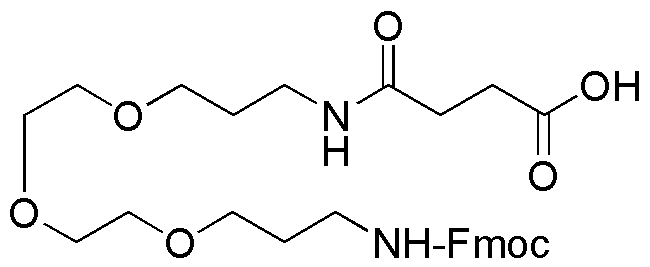Fmoc-1-amino-4,7,10-trioxa-13-tridecanamine succinimic acid is widely utilized in research focused on:
- Peptide Synthesis: This compound serves as a protecting group in peptide synthesis, allowing for the selective modification of amino acids without affecting the overall structure. This is crucial in developing complex peptides for pharmaceuticals.
- Drug Development: Its unique structure aids in the design of drug candidates, particularly in creating compounds that require specific solubility and stability profiles, enhancing bioavailability in medicinal chemistry.
- Bioconjugation: The compound is used in bioconjugation processes, linking biomolecules like proteins and antibodies to therapeutic agents, improving targeted delivery systems in cancer therapy.
- Polymer Chemistry: It finds applications in the development of functionalized polymers, which can be utilized in drug delivery systems and smart materials, offering tailored properties for specific applications.
- Analytical Chemistry: The compound is employed in analytical methods for the detection and quantification of biomolecules, providing researchers with reliable tools for studying complex biological systems.
General Information
Properties
Safety and Regulations
Applications
Fmoc-1-amino-4,7,10-trioxa-13-tridecanamine succinimic acid is widely utilized in research focused on:
- Peptide Synthesis: This compound serves as a protecting group in peptide synthesis, allowing for the selective modification of amino acids without affecting the overall structure. This is crucial in developing complex peptides for pharmaceuticals.
- Drug Development: Its unique structure aids in the design of drug candidates, particularly in creating compounds that require specific solubility and stability profiles, enhancing bioavailability in medicinal chemistry.
- Bioconjugation: The compound is used in bioconjugation processes, linking biomolecules like proteins and antibodies to therapeutic agents, improving targeted delivery systems in cancer therapy.
- Polymer Chemistry: It finds applications in the development of functionalized polymers, which can be utilized in drug delivery systems and smart materials, offering tailored properties for specific applications.
- Analytical Chemistry: The compound is employed in analytical methods for the detection and quantification of biomolecules, providing researchers with reliable tools for studying complex biological systems.
Documents
Safety Data Sheets (SDS)
The SDS provides comprehensive safety information on handling, storage, and disposal of the product.
Product Specification (PS)
The PS provides a comprehensive breakdown of the product’s properties, including chemical composition, physical state, purity, and storage requirements. It also details acceptable quality ranges and the product's intended applications.
Certificates of Analysis (COA)
Search for Certificates of Analysis (COA) by entering the products Lot Number. Lot and Batch Numbers can be found on a product’s label following the words ‘Lot’ or ‘Batch’.
Numéro de catalogue
Numéro de lot/série
Certificates Of Origin (COO)
This COO confirms the country where the product was manufactured, and also details the materials and components used in it and whether it is derived from natural, synthetic, or other specific sources. This certificate may be required for customs, trade, and regulatory compliance.
Numéro de catalogue
Numéro de lot/série
Safety Data Sheets (SDS)
The SDS provides comprehensive safety information on handling, storage, and disposal of the product.
DownloadProduct Specification (PS)
The PS provides a comprehensive breakdown of the product’s properties, including chemical composition, physical state, purity, and storage requirements. It also details acceptable quality ranges and the product's intended applications.
DownloadCertificates of Analysis (COA)
Search for Certificates of Analysis (COA) by entering the products Lot Number. Lot and Batch Numbers can be found on a product’s label following the words ‘Lot’ or ‘Batch’.
Numéro de catalogue
Numéro de lot/série
Certificates Of Origin (COO)
This COO confirms the country where the product was manufactured, and also details the materials and components used in it and whether it is derived from natural, synthetic, or other specific sources. This certificate may be required for customs, trade, and regulatory compliance.

